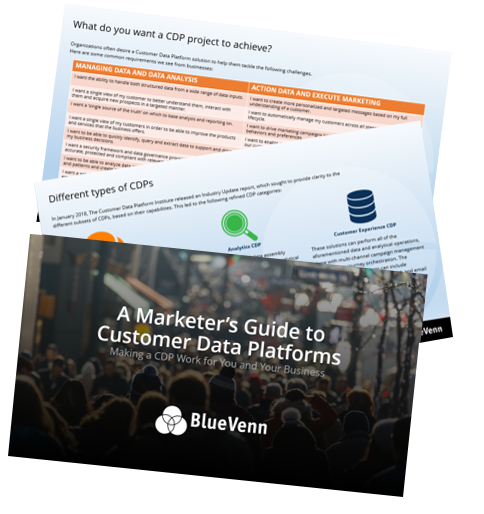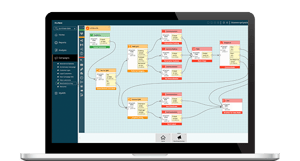 According to Gartner, “Access to customer data, in real-time, unifying profiles across channels and ability to measure comprise the competitive playing field that will define the coming years,” allowing retailers to effectively personalize cross-channel customer journeys.
According to Gartner, “Access to customer data, in real-time, unifying profiles across channels and ability to measure comprise the competitive playing field that will define the coming years,” allowing retailers to effectively personalize cross-channel customer journeys.
A Customer Data Platform, or CDP, helps by bringing in huge amounts of online and offline customer data from a multitude of sources, then cleansing, deduplicating and unifying this information into a Single Customer View that can then be accessed by all other marketing channels, platforms and business intelligence tools.
To then unify these profiles across channels, look for a CDP with ‘orchestration’ or campaign management capabilities, which will function as a ‘smart hub’ to orchestrate and trigger all your channels from a central decision-making point.
An orchestration-enabled CDP becomes an intelligent nerve center, capable of ingesting the data from multiple branded platforms, sometimes dubbed the ‘dumb spokes’, and then triggering every marketing channel, in real-time, so that campaign audiences, personalization fields, customer segments and selections are powered from the clean, compliant and trustworthy Single Customer View. The orchestration CDP manages unlimited channels for email, mobile, SMS, eCommerce, call centers, advertising and beyond as part of one customer journey, rather than triggering and executing separate campaigns using disconnected tools. The ability to push and pull data in real-time enables channels that cannot easily talk to each other become fully integrated with the CDP, which acts as connective tissue to realize cross-channel real-time marketing opportunities for the very first time, without the need to replace an entire technology stack.
Discover who your customers are and how they shop with the #1 Customer Data Platform for retailers
LIVE NEXT at:

Gain data insights into your customers’ shopping habits and needs.
Register to watch this demonstration of how analytics and real-time, omnichannel customer journey tools can be used to predict when and what your customer might be interested in buying, so you can engage them with the right message at the right time!
The CDP allows each connected channel to get on with what it does best, without being burdened and slowed down by needing to run lots of complicated apps, customizations or SDKs. Furthermore, having all the resulting behaviors, clicks, responses and transactions recorded in one place makes it easier to spot patterns, detect pain points, create segments and gain real-time insights on how to optimize customer journeys and channel effectiveness.
Avoiding fractured customer identities
Data siloes are, by definition, isolated, which can lead to gaps or overlaps in what is known about a given customer. For example, a fan of your brand may sign up to receive your newsletter and text alerts and follow you on Facebook and Twitter.

Unless you have some way of linking all these identities, chances are that when you’re running a multichannel campaign to promote a specific product, they’ll be targeted repeatedly, not at all or through the wrong channel, which is potentially a waste of money and almost certainly leads to an ineffective customer experience.
Failing to put an accurate face to a customer will result in you missing a wonderful chance to speed them towards a conversion by making an offer they can’t refuse. If a customer has been on your website looking for a certain type of product, or has searched that product many times on Instagram, a well-timed two-for-one offer sent to their cell via an app push or notification may tempt them to splash out in the moment. However, if you can’t connect the disparate insights from the stored customer interaction data and activate them into a cross-channel customer journey, that opportunity will be lost.
Predicting customer behavior
Your customer lives in Raleigh, NC and has two kids. She tends to search for toys and other kid-friendly products online around the same time each year, suggesting it is a birthday purchase. This time last year she bought a set of branded building blocks for ages 6-8 at her local store, whose loyalty scheme she is a member of. How do you know all this? Because a CDP has allowed you to build a unified customer profile that has matched her online and offline identities, purchase history and interactions.

A CDP with customer analytics and predictive modeling built-in will enable you to match her with other customers who brought the same product to determine what she might like to buy next – possibly a bolt-on kit or a new range of age 8-10 blocks? The next step might be to offer extra points on the loyalty scheme if she buys one of a selection of likely products in-store.
CDP-equipped retailers are realizing the potential they have to generate in-the-moment incentives to drive rapid purchases. Space.NK, for instance, has used its BlueVenn orchestration-enabled CDP to connect its loyalty platforms, N:dulge Cards, ecommerce platform, Twitter and POS. Connecting all branded online and offline systems has meant that the retailer’s customers can now review a product or leave a positive review on social media, to gain loyalty points that can immediately be redeemed in-store or via the website, or apply just-in-time, personalized recommendations, sent by the company to actuate upsell or cross-sell opportunities.
Fine-tuning your customer journey
A Single Customer View takes away the worst pain that most retail marketers face, which is a lack of access to all their data. With all the data at their fingertips, marketers are empowered to ask unlimited questions about their customers’ behaviors and preferences, in order to pinpoint trends and overlaps, which in turn offers the opportunity to optimize individual customer journeys.

For example, if you are able to see that a customer bought an expensive tub of face cream six months ago, and again three months ago, then it makes sense to send them a reminder that they might like to place a repeat order today. Knowing the channel that they best respond to and being able to activate insights about an individual’s repeat purchase cycle enables you to make the experience relevant, timely and effective.
An orchestration-enabled CDP makes it easier to find and act on these insights, but also to detect pinch points in a customer journey, which can inform a roadmap of positive changes that will impact your revenue. If you notice a lot of customers have looked at a particular vest top, but haven’t gone on to make the purchase, you can use the data points centralized in the CDP to identify the drop off point and take corrective action, without having to alter campaign steps in multiple execution platforms.
Would you like to talk to one of our consultants?

Simple questions are often the hardest to answer
Getting a clear view of all their data in a CDP enables marketers to answer questions that can have game-changing results. Even the simplest questions like “How many customers do we have?”, “Who are our best customers?” and “Who is going to buy this product?” can be difficult to answer if you have a fragmented or incomplete customer view. If all you have is a first name, last name, email address and mailing address, it’s easy to mistake a business buyer for a consumer.
A bathroom retailer might have two sets of customers, trade customers, who buy suites every two or three months, and consumers, who might buy one every eight years. If you’re not paying attention, you could mistake the consumer customers for lapsed customers next to the tradespeople, leading you to pepper them with annoying offers for discounted suites that they have no intention of buying for a long time. Or, conversely, you might miss out on offering trade membership to encourage more purchases by the business customers.
Linking a ‘smart hub’ with ‘dumb spokes’ saves replacing your entire technology stack
 Connecting all of your existing channels (‘dumb spokes’) to one orchestration CDP (your ‘smart hub’) means you won’t have to pay for a whole brand new, integrated marketing suite (marketing cloud), or pay extra staff to handle the demands that too many connections will place on the whole stack, slowing processes and necessitating more frequent maintenance.
Connecting all of your existing channels (‘dumb spokes’) to one orchestration CDP (your ‘smart hub’) means you won’t have to pay for a whole brand new, integrated marketing suite (marketing cloud), or pay extra staff to handle the demands that too many connections will place on the whole stack, slowing processes and necessitating more frequent maintenance.
Such problems aren’t acceptable in terms of the customer journey, and will likely lose you customers. Equally, a marketing cloud may provide all the pieces but may not offer the best channels and tools to meet your business requirements, and will certainly not play nicely with other technologies without employing expensive systems integrators. Instead, the marketing team alone should be able to handle the integration of systems and data through the CDP, allowing faster deployment of campaigns, with less disruption and a stronger ROI.
Why you need a CDP
Success in retail depends on pleasing the customer, something that is impossible to do unless you know who they are, what they want, and when and how they want it. A CDP can, by absorbing the data flowing through your ‘dumb spokes’, amalgamating it and then cleansing it for easy interpretation and use, give you all those answers and more to help you provide the best customer experience possible. With the retail space more competitive than ever, and customers expecting more, it makes sense to make the most out of your existing customer data to give your brand the edge it needs to succeed.
Want to know more? Download the ‘Marketer’s Guide to Customer Data Platforms’ eBook

Download a copy of the ‘A Marketer’s Guide to Customer Data Platforms’ eBook to gain CDP advice, learn how a CDP differs from other data management technologies, or discover different types of CDPs and what to look out for when researching technology vendors.












